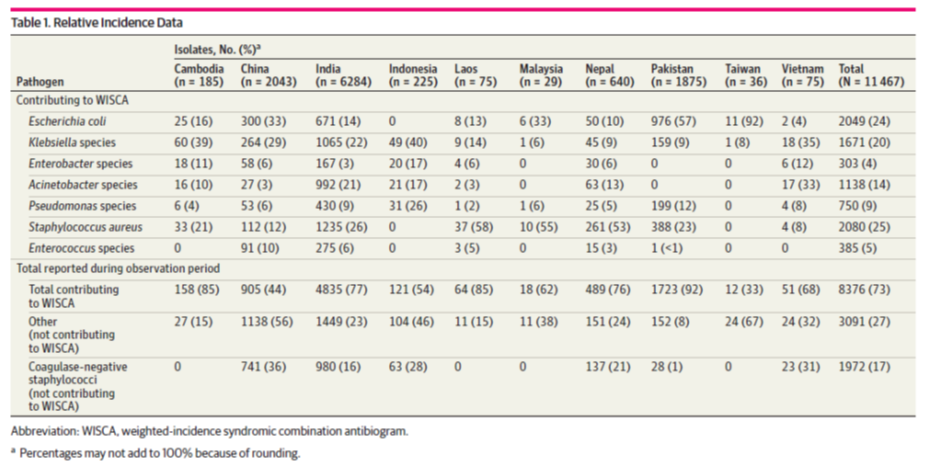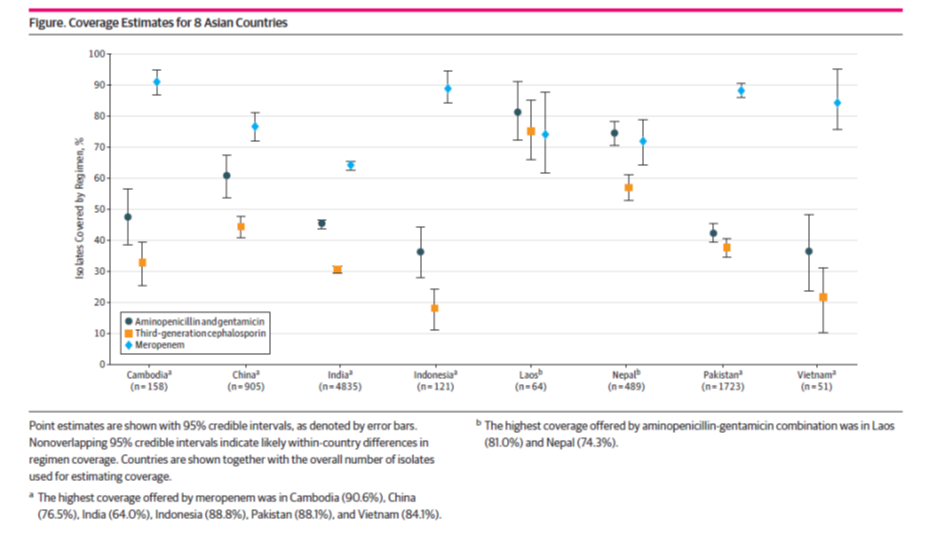Infections & Antimicrobial
REGIMENS FOR NEONATAL SEPSIS
Non-Carbapenems May Provide Limited Empirical Neonatal Sepsis Coverage in Many Asian Countries
Evaluation of the Coverage of 3 Antibiotic Regimens for Neonatal Sepsis in the Hospital Setting Across Asian Countries
High levels of antimicrobial resistance in neonatal bloodstream isolates are being reported globally, including in Asia. Local hospital antibiogram data may include too few isolates to meaningfully examine the expected coverage of antibiotic regimens.
OBJECTIVE To assess the coverage offered by 3 antibiotic regimens for empirical treatment of neonatal sepsis in Asian countries.
DESIGN, SETTING, AND PARTICIPANTS A decision analytical model was used to estimate coverage of 3 prespecified antibiotic regimens according to a weighted-incidence syndromic combination antibiogram. Relevant data to parameterize the models were identified from a systematic search of Ovid MEDLINE and Embase. Data from Asian countries published from 2014 onward were of interest.
Only data on blood culture isolates from neonates with sepsis, bloodstream infection, or bacteremia reported from the relevant setting were included. Data analysis was performed from April 2019 to July 2019.
EXPOSURES The prespecified regimens of interest were aminopenicillin-gentamicin, third generation cephalosporins (cefotaxime or ceftriaxone), and meropenem. The relative incidence of different bacteria and their antimicrobial susceptibility to antibiotics relevant for determining expected concordance with these regimens were extracted.
MAIN OUTCOMES AND MEASURES Coverage was calculated on the basis of a decision-tree model incorporating relative bacterial incidence and antimicrobial susceptibility of relevant isolates. Data on 7 bacteria most commonly reported in the included studies were used for estimating coverage, which was reported at the country level.

RESULTS Data from 48 studies reporting on 10 countries and 8376 isolates were used. Individual countries reported 51 (Vietnam) to 6284 (India) isolates. Coverage varied considerably between countries. Meropenem was generally estimated to provide the highest coverage, ranging from 64.0%(95%credible interval [CrI], 62.6%-65.4%) in India to 90.6%(95%CrI, 86.2%-94.4%) in Cambodia, followed by aminopenicillin-gentamicin (from 35.9%[95%CrI, 27.7%-44.0%] in Indonesia to 81.0%[95%CrI, 71.1%-89.7%] in Laos) and cefotaxime or ceftriaxone (from 17.9%[95% CrI, 11.7%-24.7%] in Indonesia to 75.0%[95%CrI, 64.8%-84.1%] in Laos). Aminopenicillin-gentamicin coverage was lower than that of meropenem in all countries except Laos (81.0%; 95% CrI, 71.1%-89.7%) and Nepal (74.3%; 95%CrI, 70.3%-78.2%), where 95%CrIs for aminopenicillin gentamicin and meropenem were overlapping. Third-generation cephalosporin coverage was lowest of the 3 regimens in all countries. The coverage difference between aminopenicillin-gentamicin and meropenem for countries with nonoverlapping 95%CrIs ranged from −15.9% in China to −52.9% in Indonesia.
CONCLUSIONS AND RELEVANCE This study’s findings suggest that non-carbapenem antibiotic regimens may provide limited coverage for empirical treatment of neonatal sepsis in many Asian countries. Alternative regimens must be studied to limit carbapenem consumption.



